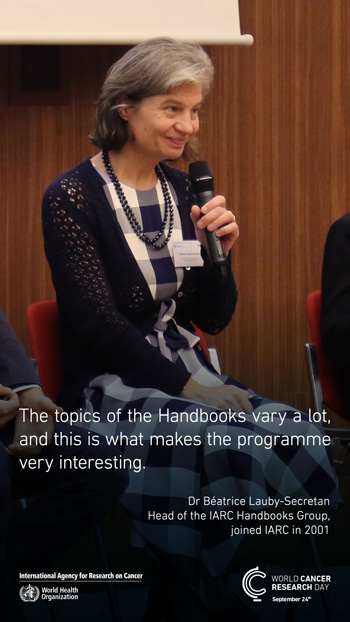❝The topics of the Handbooks vary a lot, and this is what makes the programme very interesting.❞
Please introduce yourself. How long have you worked at IARC, and where did you work before?
I am Béatrice Lauby-Secretan, Head of the IARC Handbooks Group (IHB).
I arrived at IARC in September 2001 as a postdoctoral fellow. After one year, I took a position as a scientist within the IARC Monographs programme, and soon became responsible for the Monograph section on exposure assessment. In January 2014, I was selected to lead the relaunch of the IARC Handbooks of Cancer Prevention programme within the Section of IARC Monographs. When the Section of Evidence Synthesis and Classification was created in August 2017 to combine the IARC Monographs, IARC Handbooks, and WHO Classification of Tumours, the Handbooks programme became its own Group, IHB, and I became the Group Head.
Before my almost-20-year career at IARC, I graduated with a bachelor’s and a master’s in Biochemistry from the University of Geneva, Switzerland. I then obtained a PhD in Toxicology in London, United Kingdom, followed by two postdoctoral positions in the USA, one at the Harvard School of Public Health in Boston and one at the University of California at Los Angeles.
What are the most interesting projects you are currently involved in, and why are they important?
The IARC Handbooks of Cancer Prevention evaluate which interventions and strategies can be used for cancer control. These evaluations are used by health ministries and agencies to guide the implementation of cancer control measures. The topics of the Handbooks vary a lot, and this is what makes the programme very interesting. The current Handbook is on cervical cancer screening, a disease that affects mostly low- and middle-income countries (LMICs) and yet is easily preventable; it is therefore of the utmost importance in helping these countries reduce their cervical cancer burden. The next Handbook, on oral cancer prevention, will also be very pertinent for LMICs: cancer of the oral cavity is the second most common cancer in India and kills thousands of people per year in South-East Asia. It is associated with the use of smokeless tobacco and areca nut-related products in these regions. Both of these Handbooks are being prepared in close collaboration with WHO headquarters and the WHO Regional Office for South-East Asia.
What do you do when you’re not doing research at IARC?
I started playing the cello at the age of 9 years, and my instrument has accompanied me around the world. I have played in dozens of chamber music ensembles and orchestras, and performed hundreds of concerts, in Switzerland, France, Spain, Italy, England, the USA, and even in China with the school orchestra. My cello also helped me make ends meet when I was a student. Besides music, I love travelling to far-away places and have visited, among others, Alaska, Mongolia, and Patagonia. I practice yoga, and enjoy skiing, hiking, and swimming in rivers, lakes, seas, and oceans alike.
Why did you move into research?
My career path was not planned, thought through, or anticipated. I followed opportunities, advice, and impulses, realizing only recently that I had worked in cancer research throughout my career. I did not see myself as a laboratory researcher or aspire to work in industry. As close as Lyon is to my hometown of Geneva, I found out about IARC in Los Angeles while looking to come back to Europe. Reading IARC’s mission was a revelation, and I applied for a postdoctoral fellowship to get a foot in the door. The rest is history.
Which personal scientific contribution are you most proud of?
The IARC Monographs and IARC Handbooks are not products for which one can claim ownership. Yet, I am proud to have been the Responsible Officer for several volumes of the Monographs. My single most challenging achievement to date was the preparation and publication of Handbooks Volume 15 “on a shoestring” at the same time as relaunching the Handbooks programme. I faced challenges on all sides. Despite my deep knowledge of the Monographs process, every step in the preparation of a Handbook needed tailoring. I like to say that “Handbooks are like Monographs, except that everything is different”. In addition, I had no technical knowledge of the topic, we started the project late, and the Secretariat consisted of already overcommitted staff “borrowed” from the Monographs.
Relaunching the Handbooks programme entailed tasks that stretched from creating a new website and promotional documents to updating the Working Procedures of the IARC Handbooks and the Instructions for Authors, to raising funds and managing the budget, to establishing a collaboration with a peer-reviewed journal, to managing the media interaction, all of which were new tasks to me.
What is something you do now because of research you’ve read?
I am fair-skinned and must be careful about exposure to the sun. I grew up going to the beach every summer and getting sunburns over and over again despite heavy smearing of sunscreen. Today, I would rather protect myself from the sun by wearing a hat and long sleeves and staying under an umbrella. During a recent trek in Oman under a scorching sun (40 °C in the shade), I was covered up from head to toe.

